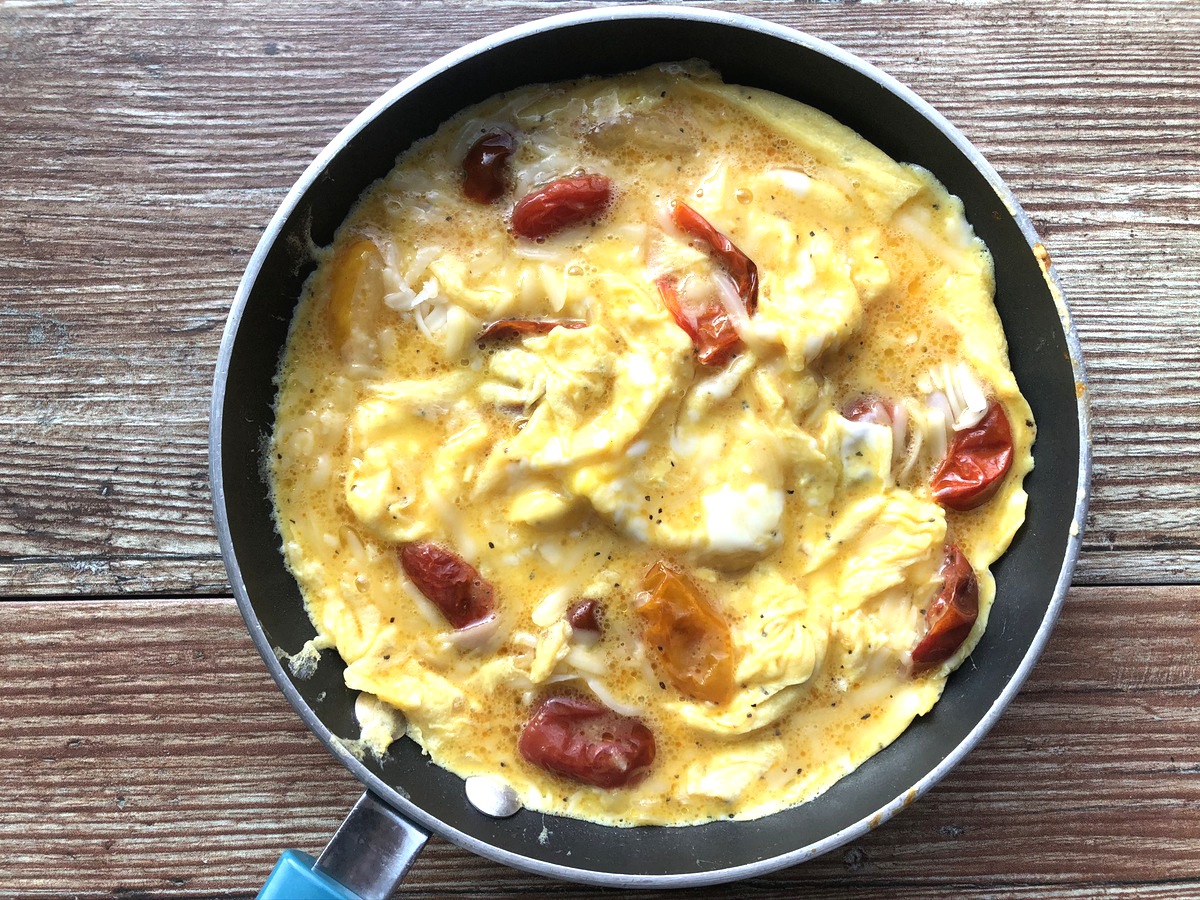A frittata is so much more than a funny word.
It’s a sensationally easy, one-dish treasure that steals the show every time. Seriously. The oo’s and ahh’s you’ll receive as you retrieve this pillowy prize from the oven will make you feel like a celebrity walking down the red carpet.
“Who are you wearing?!”, your guests will shout.
“Burst tomatoes and fontina!”, you’ll answer with a shy smile.

If you’ve ever experienced confusion when trying to determine the difference between a frittata, a quiche, and an egg casserole—let me put your mind at ease.
You’re not alone. Nobody knows! Just kidding, that’s not true.
I’m no egg expert (eggspert?), but here’s where I stand on the distinctions.
First of all, let’s clear quiche from the category. In its most traditional form, a quiche is a French tart composed of an eggy custard on top of a pastry crust.
Its counterparts, the frittata and egg casserole, most often do not possess a crust. So if they’re both egg dishes that are crustless and baked—how do we distinguish between the two?
Well, I see it this way: an egg casserole is a dish of ease.
More often than not, it’s thrown together the night before and then forty-five minutes before meal-time—into the oven it goes. A frittata, on the other hand, takes some TLC.
I like to partially cook my frittata on the stove—letting the liquidy egg drip from the top to the bottom—which creates somewhat of an omelet effect. Once the frittata’s caboose has been sufficiently browned (ever-so-lightly), I slide it into the oven for its final act.
And that concludes our lesson on eggs!
Oh, wait. Strata. Don’t even get me started on strata.
Well, okay, but only because we’re on the topic. A strata is, first and foremost, a breakfast item featured in one of my favorite holiday movies: The Family Stone.
In food terms, though, it’s simply an egg casserole that contains bread.
Though these dishes are all in the same family, quiche and strata are more like first cousins who rarely see each other—whereas a casserole is like a frittata’s younger sister who tags along with her friends and tries on her clothes when she’s not home.
Okay, enough of the egg lineage. Let’s get down to discussing the recipe-at-hand.
Want to know a secret? As I mentioned, I start my frittatas on the stove. If you’re making a smaller version of this recipe—say, with four eggs—the pan can go right from the stove to the broiler.
A frittata only needs to be baked when you’re using a larger quantity of eggs (as the middle won’t get fully cooked otherwise). The broiling is what produces that phenomenally puffy presentation, though, so that’s one step we never leave out.
As far as fillings go, the frittata-bilities are endless. I love incorporating bold, bright ingredients into mine. The sweet acidity of the burst tomatoes cuts through the fattiness of the nutty fontina and the herbaceous basil oil is the extra-special cherry on top.
Cut it into triangles, sprinkle it with parmesan, and call it a day.
A dish that resembles pizza for breakfast? Count me in.
📖 Recipe
Burst Tomato Frittata with Fontina and Basil Oil

Looking to impress your guests at your next brunch get-together? This flavorful, sunning frittata can handle that task. Baked until
golden-brown perfection with gooey fontina cheese and burst tomatoes—this basil-oil drizzled breakfast dish is a morning masterpiece. Keep reading for the full recipe.
Ingredients
- ½ cup packed fresh basil leaves
- ¼ cup extra-virgin olive oil (plus 1 tablespoon for the tomatoes)
- ¾ teaspoon coarse salt, divided
- 1 ½ cups baby tomatoes (like cherry, grape, or multi-colored heirlooms)
- 2 tablespoons unsalted butter
- ½ teaspoon coarse black pepper, divided
- 6 large eggs
- 2 tablespoons half-and-half
- 1 small shallot, minced
- 1 cup grated fontina cheese
- 2 tablespoons freshly grated Parmesan cheese
Instructions
- Fill a medium saucepot with water and bring to a boil, and prepare a small bowl with ice water. Blanch the basil leaves in the water for several seconds, and then remove them using tongs or a slotted spoon and transfer them to the ice bath.
- Thoroughly dry the leaves and then add them to a food processor or blender with the ¼ cup extra-virgin olive oil and a pinch salt. Puree until the leaves are broken down and then strain the mixture, pressing on the leaves to get as much of the concentrated flavor as you can, into a small bowl. Cover and refrigerate until you’re ready to use. The oil will keep in the fridge for several days.
- Preheat the oven to 425°F.
- In a baking dish, toss the tomatoes with 1 tablespoon of the oil, ¼ teaspoon salt, and ¼ teaspoon pepper. Roast until the tomatoes darken and begin to burst, shaking the dish halfway through, about 15 minutes. Broil the tomatoes until the tops darken, about 2 minutes.
- Lower the oven to 325°F.
- Whisk the eggs with the half-and-half and the remaining ½ teaspoon salt, and ¼ teaspoon black pepper.
- In a small nonstick broilerproof skillet over medium-low heat, add the butter and swirl to coat the pan. Once the butter begins to foam and sizzle, add the shallots. Sauté until the shallots begin to soften, about 1 minute, and then slowly stream in the eggs.
- Evenly drop in the burst tomatoes and fontina. Using a heatproof spatula, pull up the sides of the egg mixture and tilt the pan so the liquidy runny uncooked egg on the top goes to the bottom of the pan. Continue doing this until the frittata is partially cooked through and still slightly liquidy on top, 1 to 2 minutes. Sprinkle with 1 tablespoon of the Parmesan, and then place the entire pan in the oven and bake for 5 minutes.
- Turn on the broiler, and broil the frittata for 2 to 3 minutes, keeping the oven door slightly open and rotating the pan to get even heat if necessary. Keep a close eye, as the frittata can burn easily under the broiler.
- The frittata is done when it’s very fluffy and lightly golden brown on top and a toothpick comes out clean. Cut into wedges and garnish with a drizzle of the basil oil and the remaining Parmesan. Serve warm or at room temperature.
Nutrition Information:
Yield:
4Serving Size:
1Amount Per Serving: Calories: 435Total Fat: 37gSaturated Fat: 15gTrans Fat: 0gUnsaturated Fat: 21gCholesterol: 334mgSodium: 804mgCarbohydrates: 6gFiber: 1gSugar: 4gProtein: 19g
Chef’s Tips
- Double up on the basil oil and drip it over flatbreads, salads, soups, and crostini.
- To add a super savory depth-of-flavor, throw some caramelized onions or leeks into the mix.
- For easy, on-the-go breakfast sandwiches, slide a square of this frittata between ciabatta bread, add bacon, wrap it in foil, and call it a day.
- If you’re craving carbs for your next meal, amp up the amount of burst tomatoes and basil oil and toss them with goat cheese and angel hair for quick pasta perfection.
Cooking By the Numbers – BEGINNER FRIENDLY STEPS WITH PHOTOS…
Step 1 – Make the Basil Oil
Fill a medium saucepot with water and bring to a boil, and prepare a small bowl with ice water. Blanch the basil leaves in the water for several seconds, and then remove them using tongs or a slotted spoon and transfer them to the ice bath. This will keep the herb’s vibrant green color.
Thoroughly dry the leaves and then add them to a food processor or blender with the ¼ cup extra-virgin olive oil and a pinch salt. Puree until the leaves are broken down and then strain the mixture, pressing on the leaves to get as much of the concentrated flavor as you can, into a small bowl.
Cover and refrigerate until you’re ready to use. The oil will keep in the fridge for several days.
Step 2 – Make the Burst Tomatoes
Preheat the oven to 425°F.
In a baking dish, toss the tomatoes with 1 tablespoon of the oil, ¼ teaspoon salt, and ¼ teaspoon pepper. Roast until the tomatoes darken and begin to burst, shaking the dish halfway through, about 15 minutes. Broil the tomatoes until the tops darken, about 2 minutes.
Step 3 – Sauté the Shallots, Whisk the Eggs, and Grate the Fontina
Lower the oven to 325°F.
Whisk the eggs with the half-and-half and the remaining ½ teaspoon salt, and ¼ teaspoon black pepper. Mince the shallots and grate the fontina.
In a small nonstick broilerproof skillet over medium-low heat, add the butter and swirl to coat the pan. Once the butter begins to foam and sizzle, add the shallots. Sauté until the shallots begin to soften, about 1 minute, and then slowly stream in the eggs.
Step 4 – Build, Bake, and Broil the Frittata
Evenly drop in the burst tomatoes and fontina. Using a heatproof spatula, pull up the sides of the egg mixture and tilt the pan so the liquidy runny uncooked egg on the top goes to the bottom of the pan.
Continue doing this until the frittata is partially cooked through and still slightly liquidy on top, 1-2 minutes. Sprinkle with 1 tablespoon of the Parmesan, and then place the entire pan in the oven and bake for 5 minutes.
Turn on the broiler, and broil the frittata for 2 to 3 minutes, keeping the oven door slightly open and rotating the pan to get even heat if necessary. Keep a close eye, as the frittata can burn easily under the broiler.
The frittata is done when it’s very fluffy and lightly golden brown on top and a toothpick comes out clean.
Step 5 – Garnish and Serve
Cut into wedges and garnish with a drizzle of the basil oil and the remaining Parmesan. Serve warm or at room temperature.
And the Crowd Goes Wild.
Prepare yourself for roaring applause as you slide this fluffy, golden brown, almost pizza-esque casserole creation of the oven.
Pair it with a heap of crispy breakfast potatoes for a full standing ovation, and don’t forget the hot sauce.
For more exceptional egg dishes, give these gloriously yolky recipes a try:
Spinach and Bacon Frittata
Italian Baked Eggs in Tomato Sauce
One Pot Egg and Turkey Bake
























Join the Discussion